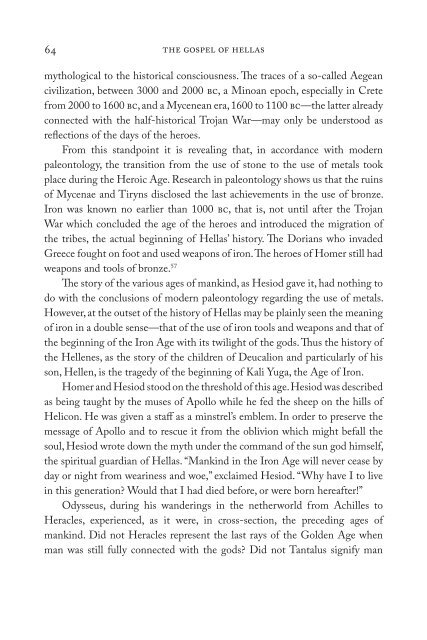The Gospel of Hellas - Research Institute for Waldorf Education
The Gospel of Hellas - Research Institute for Waldorf Education
The Gospel of Hellas - Research Institute for Waldorf Education
You also want an ePaper? Increase the reach of your titles
YUMPU automatically turns print PDFs into web optimized ePapers that Google loves.
the gospel <strong>of</strong> hellas<br />
mythological to the historical consciousness. <strong>The</strong> traces <strong>of</strong> a so-called Aegean<br />
civilization, between 3000 and 2000 bc, a Minoan epoch, especially in Crete<br />
from 2000 to 1600 bc, and a Mycenean era, 1600 to 1100 bc—the latter already<br />
connected with the half-historical Trojan War—may only be understood as<br />
reflections <strong>of</strong> the days <strong>of</strong> the heroes.<br />
From this standpoint it is revealing that, in accordance with modern<br />
paleontology, the transition from the use <strong>of</strong> stone to the use <strong>of</strong> metals took<br />
place during the Heroic Age. <strong>Research</strong> in paleontology shows us that the ruins<br />
<strong>of</strong> Mycenae and Tiryns disclosed the last achievements in the use <strong>of</strong> bronze.<br />
Iron was known no earlier than 1000 bc, that is, not until after the Trojan<br />
War which concluded the age <strong>of</strong> the heroes and introduced the migration <strong>of</strong><br />
the tribes, the actual beginning <strong>of</strong> <strong>Hellas</strong>’ history. <strong>The</strong> Dorians who invaded<br />
Greece fought on foot and used weapons <strong>of</strong> iron. <strong>The</strong> heroes <strong>of</strong> Homer still had<br />
weapons and tools <strong>of</strong> bronze. 57<br />
<strong>The</strong> story <strong>of</strong> the various ages <strong>of</strong> mankind, as Hesiod gave it, had nothing to<br />
do with the conclusions <strong>of</strong> modern paleontology regarding the use <strong>of</strong> metals.<br />
However, at the outset <strong>of</strong> the history <strong>of</strong> <strong>Hellas</strong> may be plainly seen the meaning<br />
<strong>of</strong> iron in a double sense—that <strong>of</strong> the use <strong>of</strong> iron tools and weapons and that <strong>of</strong><br />
the beginning <strong>of</strong> the Iron Age with its twilight <strong>of</strong> the gods. Thus the history <strong>of</strong><br />
the Hellenes, as the story <strong>of</strong> the children <strong>of</strong> Deucalion and particularly <strong>of</strong> his<br />
son, Hellen, is the tragedy <strong>of</strong> the beginning <strong>of</strong> Kali Yuga, the Age <strong>of</strong> Iron.<br />
Homer and Hesiod stood on the threshold <strong>of</strong> this age. Hesiod was described<br />
as being taught by the muses <strong>of</strong> Apollo while he fed the sheep on the hills <strong>of</strong><br />
Helicon. He was given a staff as a minstrel’s emblem. In order to preserve the<br />
message <strong>of</strong> Apollo and to rescue it from the oblivion which might befall the<br />
soul, Hesiod wrote down the myth under the command <strong>of</strong> the sun god himself,<br />
the spiritual guardian <strong>of</strong> <strong>Hellas</strong>. “Mankind in the Iron Age will never cease by<br />
day or night from weariness and woe,” exclaimed Hesiod. “Why have I to live<br />
in this generation? Would that I had died be<strong>for</strong>e, or were born hereafter!”<br />
Odysseus, during his wanderings in the netherworld from Achilles to<br />
Heracles, experienced, as it were, in cross-section, the preceding ages <strong>of</strong><br />
mankind. Did not Heracles represent the last rays <strong>of</strong> the Golden Age when<br />
man was still fully connected with the gods? Did not Tantalus signify man

















